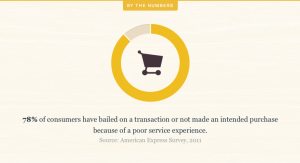3 Potential Social Media Marketing Threats To Identify Before They Appear
Social media is a powerful marketing tool for marketers. If used correctly, it means great exposure for your brand, a highway to connecting and engaging with your target audience which leads to long-lasting relationships that establishes trust. It also means traffic, newsletter signups, and potential customers coming further down your conversion funnel.
And social media can do this at a fraction of the cost that traditional display ads or most other marketing methods can. In fact, it can even do it better, if used correctly, that is.
Marketers have started to realize the many benefits of social media marketing, and as a result, more brands than ever have made social media a part of their marketing strategy. in fact, 91% of Retail Brands Use Two or More Social Media Channels today. Quite a dramatic change from only a few years ago where marketers laughed at using social media for marketing, that was considered to be something “for the kids”:
All of this proves the power of social media for brands, but while social media has a lot of benefits, it also contains plenty of dangers and threats that you can step into if you’re not cautious enough. Or more correctly, don’t identify potential threats before they appear.
But what are the common threats that can hit you before you know it, and how do you dodge them?
That’s exactly what we’ll go through in today’s article.
Hold on tight because things are about to get real.
1. Fake accounts
Fake accounts created to replicate your brand is a huge danger to your brand.
Before I get into this subject more, it’s important to separate “fan-accounts” from fake accounts.
Fan accounts are created to praise you as a brand by a very loyal customer or supporter. They have no intention to harm you or give your brand a bad reputation. Really, fan and support accounts can actually benefit you. They are actively promoting your brand and praising how good it is without asking for anything in return other than that you stay awesome, and I am sure you don’t have any plans to change to the worse any time soon.
Take a look at the Instagram account @Koenigseggmotors.

The Instagram praises how amazing the Swedish car manufacturer is in every single post they share, and they’ve been able to accumulate over 1 million followers while doing so. That’s a ton of free, great exposure to the brand. In the bio of the profile, they clearly state in two places that they are in no way affiliated with the Koeniggsegg brand in any way, to avoid confusion.
This is an example of a positive fan account that brings a lot of exposure to the brand it is praising.
Here is the real account that belongs to Koeniggsegg:

What is especially tricky in this situation is that the fan account has more followers than the real brand’s Instagram account, and this is something that doesn’t happen too often. When people are looking for the real deal, they’re often looking at the account that has the most followers, and because this isn’t the case, it can cause a bit of confusion.
But unfortunately, there are not only positive fan accounts. There are also people who are creating fake accounts and straight off are imitating other brands, trying to come off as the real deal. When this happens, that is when it gets dangerous for your brand.
However, with the account that is created to support Koenigsegg, there is no potential danger due to the fact that the fan account has so clearly stated in their profile that they aren’t affiliated with the brand. However, if the account would be a negative fake account, it would have been an especially dangerous situation.

The big threat
Accounts that replicate your business don’t seem too bad considering the last example. What is the real issue with fake accounts?
Well, the problems are quite widespread and they can damage you on many different levels.
They can harm your customer service reputation
This is a big one when it comes to accounts created to replicate your brand. If someone has created a fake account, there’s a risk that customers will mistake that to be the real deal and go to it for customer service inquiries. If the creator of the account has the intention to hurt you, it can be devastating.
Imagine this scenario:
A potential customer writes to the fake account asking a question. For the sake of this example, let’s say they write “How can I order a pair of socks from your store?.
When the fake account sees this comment, they take the opportunity to damage your brand’s reputation by responding “Are you poor, why are you only going to buy one pair of socks?”
As you can imagine, there can be millions and millions of ways a similar conversation like this can evolve, but nonetheless, all of them will hurt your brand. In the belief that the response actually came from someone working for your brand, what do you think they’ll think about you?
Most likely, they’ll cringe every time they hear your brand, and they’ll tell all their friends about the bad experience they had with your brand. Some might even take it to social media to let everyone know how horrible you are as a brand – even if you had nothing to do with the interaction they just had.

Even if the interaction is that awful, it can still be harmful to your brand. Did you know that 78% of consumers have bailed on a transaction or not made an intended purchase because of a poor service experience? Well, that statistic alone will tell you the danger of someone mistaking a fake account on social media as your real page.

What if someone writes to the fake account and asks a question but doesn’t receive any response? While the fake profile isn’t directly harming your brand, the fact that the customer doesn’t get a response from what they think is your brand will have a negative effect on how they perceive your brand.
Fake campaigns
This scenario could take place if someone who truly hates your brand wants to hurt you.
They can create a fake campaign in your name and present a deal that almost sounds good to be true, but because it comes from your brand, (at least by the looks of it) people fall for it. That day, you might have people who are eagerly calling and emailing you wanting to know how they can access the amazing deal of (let’s say 80% off on everything). Even worse, the fake profile might create even more harmful campaigns where all of your customers will get 50% of their previous purchases from you back.
What will you tell to all of those people?
While you can explain that your brand has been replicated and hijacked on social media, it will still lead to a lot of disgruntled customers.
Solution
To avoid all of these scenarios from happening, as a result of someone replicating your brand on social media, you need to develop a crisis plan that tells you exactly how you are going to act when it happens so that you can quickly identify and neutralize the accounts that are replicating and harming your brand.
First, you need to work proactively and actively to identify any fake accounts that can become potential threats to your brand. Second, you need to have governance in place to warn customers so that they don’t fall for it. You also need to have a solution in place that tells you how you’re going to deal with the people who have already been affected so that they don’t leave feeling hatred against your brand.
Last but not least, you need to have a solution to how you’re going to quickly get the pages that have already started to cause damage to your brand down. Will you call the social platform? Will you report the account?
Most of the time, reporting an account through the social platform takes time. It can take days or even weeks before the account is finally taken down, and in the meantime, they can do a lot of bad things.
Therefore, your crisis plan should tell you exactly what approach you’re going to take to get the page down in the shortest amount of time.
2. Disgruntled customers
Let’s continue to another big threat for brands on social media.
This isn’t something that is caused by someone who is replicating your brand or trying to do your brand harm anonymously. This is just the results of angry customers who haven’t had a good experience with your brand.
Most of the time, this threat is all on you, accordingly, the solution is on you as well.
All brands will have angry, disappointed, and disgruntled customers. Whether you admit it or not. It’s just a normal part of the process. And that’s fine!
But what will have the biggest effect is how you deal with these angry customers.
Now to the big threat. When customers aren’t satisfied with your brand, they might turn to social media to tell their friends about their experience with your brand. Most of the time, customers aren’t turning to social media to warm everyone how bad you’ve behaved and how terrible your customer service is after one misstep from your brand. Normally, it is after several bad interactions that they get tired.
To solve this issue, you need to do two things. First, you need to do your very best to minimize the number of people who get angry at your brand. Now, as you know, it is impossible to please all and it is equally difficult to avoid making mistakes, but when you do make mistakes, you need to make sure that you quickly go out of your way to make things right again.
I mentioned that 91% of unhappy customers will not willingly do business with you again, but did you also know that if you resolve a complaint in the customer’s favor, they will do business with you again 70% of the time?
This is not all. If you succeed in resolving a customer complaint, you will also save yourself from the bad exposure that comes with this whole point: disgruntled talking trash and spreading negativity about your brand as a result of a bad experience.
Take a look at this customer complaint directed towards Zappos:

If this would have been the end of the story, we can be quite sure that Donna would turn to social media to tell all her friends about her bad experience with Zappos, thus giving them negative exposure.
Luckily, it doesn’t end there.
Fortunately, Zappos quickly identified the customer complaint and really went out of their way to make their angry customer happy again.

This interaction also showed other already existing – and potential customer of Zappos that they are handling social media in a great way, even if the message was negative and can give a negative image of the brand when other people are seeing it.
In this case, the customer took it directly to the brand’s Facebook page to complain, which many do, but if you can identify and solve the problem when they contact you through email or private message, you can avoid getting negative exposure out in the public. Getting people who complain about your own social media account is normal for brands and nothing that harms you to a too big of a degree as long as you solve their problem in a good manner so people can see how great customer service you have. But the harmful threat is when they take it to their very own social media page and write an “announcement” rather than sending you a complaint.
The reason for this is that these messages are normally not written by the angry customer because they except any type of response from you.
They just want to tell their friends about their bad experience. And many times, they don’t mention your brand by name which gives you very little opportunity to jump into the conversation and show that you care and want to make things right.
3.Skepticism
This is an issue that is especially happening to old brands who are stuck in a rut and uses the same marketing methods they’ve always done – which is, pouring money into traditional display ads which are losing effectivity.
Entrepreneur Gary Vaynerchuk once said in his podcast that the reason why brands are still pouring money down the drain – which is exactly what they are doing when they pay for display advertising, is because it is “socially acceptable” within the company.
People within the company do it without being questioned – even if the results can’t be proven – because it is accepted in the company culture.
But when it comes to social media, it is a completely different ball game. Then, results need to be proven on the dollar.
In an article, Vaynerchuk also wrote:
“There are two places right now that companies need to be focusing to win their marketing game. One is mobile, and the social networks contained within mobile. The second is video.
Anyone who doesn’t realize that the cell phone is exactly the same thing that the television was in 1965 is completely ignoring the future. When an ad comes on, when pre-roll shows up, people reach for their phones. As soon as the experience they were trying to have is interrupted by an invasive ad, the phone is where they turn to continue being entertained. Plus, the phone is always there. As you read this, is your phone within five feet of you? I thought so.”

When I say skepticism, I am talking about the difficulty as someone who genuinely believe in social media marketing and who knows that it works to introduce and convince the rest of the team that it is something they need to use.
As someone who is convinced that social media works and that you need to start using it unless you want to lose ground and fall behind, the biggest challenge you’ll face in a conservative business when trying to convince the rest of your team is skepticism.
Convincing is a slow process, but it is extremely rewarding at the end.
The big obstacle is being able to clearly say “this works” because it takes time and effort to generate great results.
The statistics about social media are incredible, but unless you have a strong strategy, you won’t reach them. It takes time and efforts and I understand that not all organizations have the resources, especially human ones, to commit to it.
Gary Vaynerchuk continues in his article: “It baffles me that so much money is still spent on forms of advertising that are not beneficial to the consumer, nor where the current consumer attention is. Pre-roll ad views. Commercial breaks on streaming sites. These are the “impressions” marketers are focusing on. Why? There are better places money should be spent with bigger upsides. Great marketing should feel like a renovation, not a rehash of what has been done before.”
Do you have any other potential threats when working with social media marketing you would add to the list?
Let me know in the comment section below! I’d love to hear about them.


